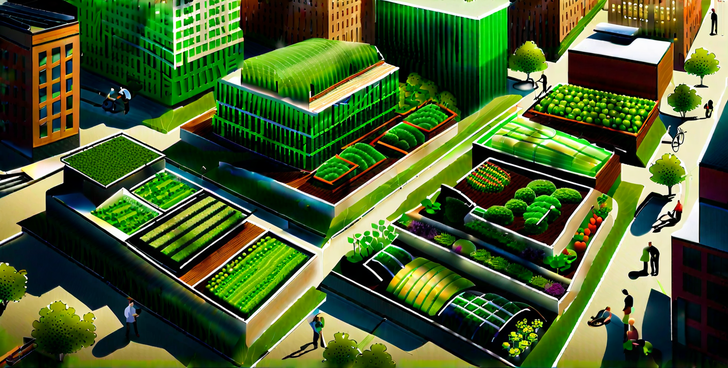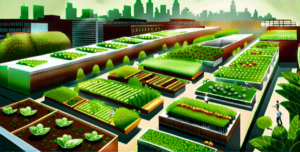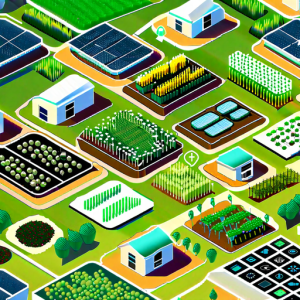Urban Agriculture : A quiet revolution is taking place across the world’s urban landscapes. Cities, once the epitome of concrete and steel, are now transforming into lush, green expanses. This metamorphosis is the result of the burgeoning trend of urban agriculture.
Importance of Regulatory Standards
As urban farming morphs from niche hobby to mainstream movement, regulatory standards must be established and enforced. This ensures the safety of both consumers and workers, while facilitating an environment conducive for urban agriculture to thrive.
Understanding Urban Agriculture
Defining Urban Agriculture
Urban agriculture encapsulates the cultivation, processing, and distribution of food within city boundaries. From rooftop gardens to reclaimed vacant lots, urban farming is an innovative solution to localized food production.
Benefits and Challenges of Urban Agriculture
Urban agriculture has its merits, most notably in providing fresh, local produce, reducing food miles and creating vibrant communities. Conversely, challenges lie in areas of safety, sanitation, land use, and more, necessitating clear guidelines and regulatory standards.
Ensuring Safety in Urban Agriculture
Food Safety Measures
Quality Control and Testing
Rigorous quality control procedures are crucial, involving regular testing for harmful pathogens and toxic substances.
Pest and Disease Management
Methods of pest and disease management must align with the ethos of sustainability, veering away from harmful pesticides and towards natural alternatives.
Proper Handling and Storage
Safe handling and storage practices are paramount to prevent foodborne illnesses.
Water and Soil Safety
Monitoring and Testing
Monitoring and testing are pivotal for detecting water and soil contaminants, ensuring the safety of the produce.
Contamination Prevention Strategies
Strategies must be in place to prevent contamination, focusing on source management and risk reduction.
Health and Sanitation Guidelines
Worker Safety
Protective Equipment and Training
Workers should be furnished with proper protective equipment, and training should be provided for handling agricultural tools and machinery safely.
Hazardous Chemicals Management
Proper handling, storage, and disposal of hazardous chemicals should be mandatory, minimizing potential health risks.
Waste Management
Composting and Recycling
Organic waste should be composted or recycled, not only to reduce waste but also to enrich soil fertility.
Waste Disposal Practices
Waste disposal practices should be environmentally friendly, minimizing any adverse impact on the urban environment.
Zoning and Land Use Regulations
Land Allocation and Zoning
Balancing Residential and Agricultural Spaces
Striking a balance between residential and agricultural spaces is crucial, ensuring urban farms can coexist with residential properties without conflict.
Land Use Planning for Urban Farms
Effective land use planning is necessary to identify suitable locations for urban farms, taking into account factors such as sunlight exposure, soil quality, and proximity to markets.
Urban Agriculture in Public Spaces
Rooftop Gardens and Vertical Farming
Public spaces such as rooftops can be used for urban farming, and vertical farming can maximize yields within limited spaces.
Community Gardens and Allotments
Community gardens and allotments can help foster community bonds, while providing valuable green space within the cityscape.
Building and Infrastructure Requirements
Structural Safety
Building Codes and Permits
Urban farming structures, from greenhouses to rooftop gardens, must comply with local building codes and permits, ensuring structural safety and resilience.
Greenhouse and Aquaponics Systems
Greenhouse and aquaponics systems should be designed and maintained to high safety standards, to prevent any accidents or structural failures.
Irrigation and Water Management
Rainwater Harvesting
Rainwater harvesting should be implemented where possible, to conserve water and provide a sustainable water source.
Drip Irrigation Systems
Drip irrigation systems are highly efficient, reducing water waste and providing controlled irrigation for crops.
Licensing and Registration
Obtaining Necessary Permits
Local Government Regulations
Urban farmers should obtain all necessary permits in compliance with local government regulations, ensuring legal and safe operations.
Health Department Approvals
Health department approvals should be sought, particularly for operations involving the sale of fresh produce or value-added products.
Business and Trade Licensing
Selling Produce and Products
To sell produce and products, farmers should secure business and trade licenses, aligning with regional trade practices and business regulations.
Farmers Market Participation
For participation in farmers markets, specific licenses may be required, further emphasizing the importance of adhering to local regulations.
Best Practices for Urban Agriculture
Crop Selection and Rotation
Suitable Crops for Urban Settings
Choosing suitable crops for urban settings is vital for maximizing yields. This may include high-yield crops that require less space, such as leafy greens or herbs.
Maximizing Yield and Sustainability
Crop rotation practices can help to maximize yields and maintain soil fertility, enhancing the sustainability of urban farming operations.
Integrated Pest Management
Natural Pest Control Methods
Natural pest control methods, such as introducing beneficial insects, can help manage pests without the use of harmful chemicals.
Minimizing Pesticide Usage
Minimizing pesticide usage not only benefits the environment but also ensures the health and safety of consumers and workers.
Community Engagement and Education
Collaborating with Local Institutions
Schools and Universities
Partnerships with schools and universities can be formed, fostering a culture of sustainability and instilling the concept of urban farming in younger generations.
Nonprofit Organizations
Nonprofit organizations can provide valuable resources and support, further bolstering the success of urban farming initiatives.
Outreach Programs and Workshops
Teaching Urban Farming Skills
Outreach programs and workshops can be conducted to teach urban farming skills, promoting self-sufficiency and community resilience.
Promoting Healthy Eating Habits
Urban farming can be an effective tool for promoting healthy eating habits, by providing access to fresh, locally grown produce.
Economic Viability and Financial Support
Business Planning and Market Analysis
Determining Market Demand
Determining market demand for urban farmed products is key to the economic viability of urban farming operations.
Financial Forecasting and Budgeting
Effective financial forecasting and budgeting can help ensure the long-term success of urban farming initiatives.
Grant and Funding Opportunities
Government and Nonprofit Programs
Government and nonprofit programs can provide vital funding and grants, supporting the setup and growth of urban farms.
Crowdfunding and Community Support
Case Studies of Successful Urban Agriculture Projects
Urban Farming Success Stories
Examples of Profitable Urban Farms
There are numerous examples of profitable urban farms across the world, providing tangible models of success for aspiring urban farmers.
Innovations and Technological Advancements
Innovations and technological advancements, from hydroponics to vertical farming, are propelling the urban agriculture movement forward.
Community-Driven Initiatives
Transforming Neglected Spaces into Gardens
Community-driven initiatives are transforming neglected spaces into thriving gardens, demonstrating the transformative power of urban farming.
Social Impact and Empowerment
Urban farming projects can have a profound social impact, promoting community cohesion and empowerment through a shared sense of purpose and achievement.
Global Perspectives on Urban Agriculture Regulations
International Approaches
Urban Agriculture Policies in Different Countries
Different countries have different approaches to urban agriculture, from policy frameworks to regulatory mechanisms. These diverse experiences offer valuable lessons for developing effective urban agriculture strategies.
Lessons Learned and Best Practices
Drawing on these international experiences can help to identify best practices and effective strategies, informing the development of effective local regulations.
Collaborative Efforts and Knowledge Sharing
Global Networks and Organizations
Global networks and organizations can facilitate knowledge sharing and collaboration, enhancing the collective understanding and development of urban agriculture.
International Conferences and Summits
International conferences and summits provide a platform for stakeholders to exchange knowledge, fostering an environment of shared learning and collaboration.
Overcoming Challenges and Future Outlook
Addressing Legal and Regulatory Gap
Advocacy for Supportive Policies
Advocacy for supportive policies is key to overcoming legal and regulatory gaps, helping to create a conducive environment for urban farming.
Regulatory Reforms and Updates
Regulatory reforms and updates are needed to ensure regulations stay current with evolving practices and technologies.
Technological Advancements and Innovation
Smart Farming and Precision Agriculture
Technological advancements, such as smart farming and precision agriculture, can enhance productivity and sustainability.
Automation and Artificial Intelligence
Emerging technologies like automation and artificial intelligence hold the potential to revolutionize urban farming, boosting efficiency and scalability.
Conclusion of Regulatory Standards Safety and Implementation Guidelines for Urban Agriculture
Importance of Regulatory Standards for Urban Agriculture
Regulatory standards are an indispensable aspect of urban agriculture, ensuring safety, sustainability, and fairness.
Moving Towards Sustainable and Safe Urban Farming Practices
As we move towards the future, a paradigm shift is needed towards more sustainable and safe urban farming practices, facilitated by robust regulatory standards and a culture of innovation and collaboration.
FAQs
Q1 How can urban farming contribute to community engagement?
Ans: Urban farming can foster community engagement by offering shared green spaces, promoting local food production, and facilitating education and outreach programs.
Q2 Are there financial supports for urban agriculture initiatives?
Ans: Yes, financial supports can come from various sources such as government grants, nonprofit programs, and crowdfunding initiatives.
Q3 What kind of crops are suitable for urban farming?
Ans: High-yield and space-efficient crops such as leafy greens, herbs, and vegetables are typically suitable for urban farming.
Q4 How is technology influencing urban agriculture?
Ans: Technology is transforming urban agriculture through advancements like vertical farming, hydroponics, precision agriculture, and automation.
Q5 What does the future of urban agriculture look like?
Ans: The future of urban agriculture looks promising with increased community involvement, technological innovation, and supportive policies and regulations.
Our Reader’s Queries
What is the meaning of urban agriculture?
Urban agriculture involves growing, processing, and distributing food in urban areas. It also includes animal husbandry, aquaculture, beekeeping, and horticulture. These practices are carried out in an urban setting, making it possible for city dwellers to have access to fresh produce and other food products. With urban agriculture, people can enjoy the benefits of locally grown food, while also reducing their carbon footprint. It’s a great way to promote sustainability and healthy living in urban areas.
Is urban farming worth it?
Urban agriculture is a powerful tool that not only encourages healthy eating habits but also fosters strong community bonds among neighbors (Ilieva et al., 2022). This practice offers a wide range of benefits to local communities, making it an excellent way to support overall health and well-being. By bringing people together through the cultivation of fresh produce, urban agriculture helps to create a sense of shared purpose and connection that can have a positive impact on everyone involved. Whether you’re looking to improve your diet or strengthen your community ties, urban agriculture is a great way to achieve both goals at once.
What is urbanization in agriculture?
Urban agriculture refers to the practice of cultivating crops and raising small livestock or milk cows in small areas within the city, such as vacant plots, gardens, balconies, and containers. This practice can serve as a source of food and income for urban residents, as they can consume the produce themselves or sell it in local markets.
Is Urban Farming Sustainable?
Urban farming is a sustainable practice that is both local and often organic. It is typically small scale, making it a cost-effective option for producing food close to the market. This allows for lower prices and helps to improve food security in cities. Not only is urban farming environmentally friendly, but it also makes good business sense.



